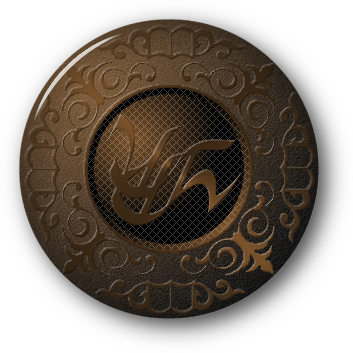

|
|
The Birth of D'ni Linguistics The study of the D'ni language began in the mid 1990s, shortly after the release of Myst and the publication of the first novels chronicaling the history of Atrus and his family. Specifically, the reproduction of Aitrus' map meD'nE bretalEo (From D'ni to the Surface) included in many copies of the Book of Ti'ana was the first D'ni document to be released to the public. Cyan, Inc. (now Cyan Worlds) created a website (now dead) that provided English translations of the various D'ni texts on the map. A handful of groundbreaking linguists, among them Telanis, Erithan, Sne'vir, and Coronus, worked to decipher the D'ni alphabet and make sense of the translations. Primarily assisted by Richard A. Watson, a full understanding of the texts was soon reached. Contact with Watson (a.k.a. RAWA) allowed for an early flowering in D'ni linguistics, as RAWA was and remains to this day Cyan's primary D'ni historian and the foremost expert on the D'ni language. In persuit of their studies, the early members of the linguistic community organized themselves into a group known as the Circle of D'ni. The group was small in number and carefully tended its knowledge of D'ni; its philosophy held the language as a worthy subject of learning and education, rather than a collection of trivia. To gain access to the privileged information acquired from RAWA, one needed to demonstrate a genuine interest in D'ni. The language that the Circle had worked so hard to discover, to decipher, to cherish, could be easily degraded if an unknowing public mishandled it. Just as rumors surrounding Myst's upcoming sequel, Riven, began to circulate in earnest, one of the members of the Circle of D'ni broke from the organization's discretion, and the Circle's wordlist soon appeared on a public website. The repercussions were significant: wordlists took root across the Internet, simple (and often incorrect) D'ni began creeping into the common parlance, and the Circle eventually dissolved. With the memory of an intimate, devoted passion for a common language and a unique relationship with Cyan strong in their minds, most of its members retreated "into the woodwork," pursuing D'ni more privately. Populist Renaissance Riven saw its phenomenal release in 1998, and the interest in D'ni exploded. The language had been incorporated so naturally into the immersive game that fans wanted to understand just what was being said. A new generation of linguists emerged, populist in its philosophy and ambitious in its goals. Simon and Josef Riedl founded the Guild of Linguists, which soon became a center of learning and reference for all D'ni linguists. The Writers of D'ni MOO, an interactive role-playing environment based on the D'ni world of 7500 DE, also became a haven for linguists, with an active guild life under Guildmaster Do'vahth. A few tried their hand at designing a D'ni font, including Coronus, Tekis, and Jehon, and a new standard for transliteration was established with a one-to-one correspondence to eliminate the ambiguities of the original standard in use since the language's birth. A critical eye was also turned to the D'ni alphabet; in short order, an undeniable connection to the D'ni numbering system was discovered. Gordon Currie, founder and maintainer of popular Rivenguild website, revealed details about his visit to Cyan headquarters and about the mysterious MUDPIE project in his GRID web series, which employed a number of D'ni language puzzles. The bar for wordlists was raised with Kh'reestrefah's Dictionary of the D'ni Language, which remains to this day one of the best vocabulary resources available. For a while, a great deal of attention was devoted to the texts appearing in Riven and the game's soundtrack, but once these materials were thoroughly digested, few new discoveries were made and linguistic interest began to diminish. Rivenguild closed its doors, a great loss for the fan community, and Cyan remained tight-lipped about its MUDPIE project. With only a short resurgence upon the release of Exile, D'ni studies stalled. The Modern Revival Then, in 2003, invitations from a mysterious figure named Jeff Zandi began appearing in inboxes across the web. Sworn to silence, members of the fan community were slowly invited to test Cyan's new game, Uru. Beta testers knowledgeable about the D'ni language voraciously tore through new texts — the old linguistic fire was stoked in many a student of D'ni. A number of testers discovered errors and offered corrections to inaccurate in-game texts, which were duly corrected before Uru's public release. At about the same time, Leenay recognized that no spot on the web had been established for D'ni language discussions, and so founded the languagelyst, where many of the Uru texts were first publicly discussed. Another result of beta testing was the emergence of common interest neighborhoods and organizations. First among those was the Guild of Greeters under Guildmaster Tijara, which became a model for many others, among them the D'ni Linguistic Fellowship. Co-founded by Jerle and Domahreh, the DLF aspired to create a welcoming community in UruLive for all who took an interest in the D'ni and ahrotahn languages, with the ultimate goal of offering in-cavern classes. When UruLive was cancelled, rather than abandon its already sizeable community, the DLF offered resources and support to its members with various projects, including this set of lessons. |
Myst, the Myst logo, and all games and books in the Myst series are registered trademarks and copyrights of Cyan Worlds, Inc. Myst Online: Uru Live is the sole property of Cyan Worlds Inc. The concepts, settings, characters, art, and situations of the Myst series of games and books are copyright Cyan Worlds, Inc. with all rights reserved. I make no claims to any such rights or to the intellectual properties of Cyan Worlds; nor do I intend to profit financially from their work. This web site is a fan work, and is meant solely for the amusement of myself and other fans of the Myst series of games and books. |